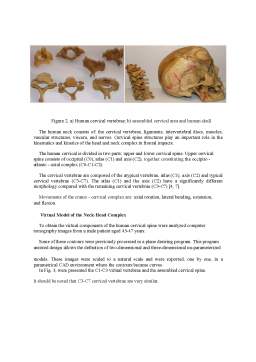Extras din referat
Keywords: cranio-cervical complex, car crash, main movements, biomechanical behavior, shape memory alloys.
Abstract. This paper presents the studies made on a similar biomechanical system composed by neck, head and upper thorax, bones and muscles.
The model was defined in a CAD environment, starting with a real human object and which was made CT. After settled the main movements (axial rotation, lateral bending, and flexion-extension) we obtained the entire biomechanical behavior based on date, tables or diagrams.
The virtual model composed of the neck, head and upper thorax, which we included in a complex system (as a car system), and supposed to have several impact simulations (virtual car crash tests). We have also studied the behavior of shape memory springs, with which we have achieved anatomical-functional similarity with those of a human subject, comparing them in the end with the ones determined virtually with anatomical-myographic studies.
Introduction
The objective of this research was to develop a virtual biomechanical model of muscle powered human system consists of head and neck, a system that could be used to simulate the impact behavior for auto front neck [1, 2, 3].
Using computer-aided design (CAD) and dynamic simulation programs was developed a virtual model of the human spine capable to be simulated “in vitro” experiments. This model "in vitro" includes the main muscle groups simulated by springs with dynamic parameters, nonlinear and variable.
The development of this biomechanical model of human head-neck system was based on a previous model “in vivo”. Were defined interconnection joints, inter-vertebral discs, joints, ligaments, including C0-C1-C2 vertebrae complex. Neck muscles were considered as driven elements for the study that included the main types of movements (displacements) axial rotation (left-right), lateral bending (left-right) and flexion-extension movements.
The subject of this paper draws knowledge from different fields (anatomy, surgical techniques, orthopedics, mechanical, bio-mechanisms, computer, technical graphics, computer aided design).
Anatomical Aspects of the Human Neck-Head System
We left the study of the cervical area with computerized tomography of a cranial-cervical area of a 43-year-old male patient (Helios Policlinic, Craiova) with Siemens equipment: Magnetom Avanto 1.5T magnetic resonance device and a computed tomography machine Somatom Spirit, 2009.
CT Scan or CAT Scan is an imaging technique that uses X-rays to scan internal body structures and make detailed images of them. The device is called a CT scanner and consists of two components: the scanner (scanner), that is, the X-ray scanner and the computer that takes the scanning data, and then creates the three-dimensional and scanned organ section images.
In Figure 1 we represented we represented scanning the musculocervical area and the skull
Figure 1 a) dorsal view of the cervical area; b) the cervical muscles, which make the connection between the cranial tone and the cervical area
The CT images were then compared simultaneously, to the dimensions of the vertebrae and the skull, equipped at the pathology laboratory, at very close adult human (didactic material of the University of Medicine in Craiova. realizing the geometric model of the cervical vertebrae In this sense, were recreated parallel planes (transverse, coronal and sagittal) at specified distances from each tomography scheme. In each plane were redrawn contours for each image and each vertebra. Also, the same method was used for the mandible, skull bones and upper thorax (Figure 2).
Figure 2. a) Human cervical vertebrae; b) assembled cervical area and human skull
The human neck consists of: the cervical vertebrae, ligaments, intervertebral discs, muscles, vascular structures, viscera, and nerves. Cervical spine structures play an important role in the kinematics and kinetics of the head and neck complex in frontal impacts.
The human cervical is divided in two parts: upper and lower cervical spine. Upper cervical spine consists of occipital (C0), atlas (C1) and axis (C2), together constituting the occipito - atlanto - axial complex (C0-C1-C2).
Bibliografie
1. G. Abedrabbo, Simulation of a frontal crash test using multibody dynamics, Universite catholique de Louvain, Center for Research in Mechatronics, Belgium, 2009.
1. M.R Maltese et al., Injury Mechanisms in Seat Belt-restrained Occupants in Side Impact Crashes, Crash Injury Research and Engineering, Network (CIREN) Public Meeting Washington, DC, USA, 2007.
1. M.J. Van der Horst, Human Head Neck Response in Frontal, Lateral and Rear End Impact Loading - modelling and validation -, PhD Thesis, Eindhoven University of Technology, Maastricht University and the TNO Crash Safety Centre. - Eindhoven: Technische Universiteit Eindhoven, Proefschrift., 2002.
1. J. Yan, A Computer Simulation Model Of The Human Head-Neck Musculoskeletal System, PhD Thesis, The University of Tennessee and The University of Memphis, 2006.
1. SolidWorks, User Guide and Tutorials, 1995-2010.
1. Adams, User Guide and Tutorials, 2001-2004.
1. Agur, Anne M.R.; Dalley, Arthur F. Grant's Atlas Of Anatomy, 12Th Edition - Lippincott Williams & Wilkins 2009, TitleLippincott Williams & Wilkins
1. Ciunel St.; Duta A.; Popa D-L; Popa-Mitroi, G.; Dumitru, V-C, The Behavior of the Virtual Human Head-Neck System during the Main Movements, Applied Mechanics & Materials . 2014, Issue 657, p780-784. 5p.
1. G. Buciu, D. Grecu, D. Niculescu, L. Chiutu, M. Stoica, D. Popa, Studies about virtual behavior of tibia fractures and nails during the fixation process., Journal of Industrial Design & Engineering Graphics 8 (2) (2013) 5-10
1. D. Popa, D.N. Tarniță, D. Tarniță, D. Grecu, The generation of the three-dimensional model of the human knee joint, Romanian Journal of Morphology and Embriology, Ed. Academiei Romane, 46 (4), (2005) 279-281
Preview document
Conținut arhivă zip
- Studies about in vivo and virtual of the musculoskeletal behavior of the cranio-cervical complex of dummy car crash tests.docx








